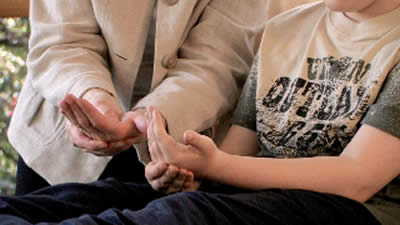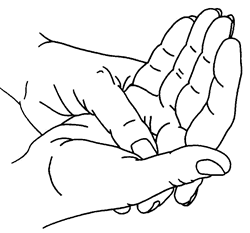Positive Health Online
Your Country

Reflexology and Breathing Techniques for Respiratory Issues
listed in reflexology, originally published in issue 201 - December 2012
During the winter months many people will succumb to coughs and colds and, although the initial acute symptoms may disappear quite quickly, a person can be left with a residual tickly cough, slight breathlessness or tightness in the chest. Self-help hand reflexology plus some simple breathing techniques suggested by voice practitioner, Christina Shewell, may often help to ease these irritating symptoms and accelerate a return to full health.

Many people are shallow breathers but can rapidly increase their lung capacity by applying some simple breathing exercises in tandem with a few reflexology techniques to relax the diaphragm, stimulate the lungs and boost the immune system. How quickly we recover from a cough is often dependent on how well our lungs are working generally. Whether well or ill, we all owe it to our bodies to breathe more deeply, get plenty of fresh air and avoid inhaling harmful pollutants like chemical fumes and cigarette smoke. Breath is life and every minute we breathe in and out about 15 times. The lungs are the main organs of the respiratory tract and the diaphragm is a large, muscular wall that points upwards towards the lungs. When it contracts, during inspiration, the atmospheric pressure in the lungs decreases, causing the air to rush in. When the opposite happens, the diaphragm relaxes as the air rushes out as the carbon dioxide, which has been extracted from the blood, flows out.
The hands have the same reflexology reflexes as the feet and are much easier to access for self-help techniques.. For example, the bronchial tube reflexes are situated in the webbing between the thumb and forefinger and on the base of those two digits. If a person wakes in the night with a tickly cough it is sometimes helpful to have a drink of water followed by a short session of the following reflexology techniques. These techniques can also be applied during the day at any time.

Diaphragm Rocking
Method
- Place your thumb on the ball of your hand just below the forefinger and middle finger and slowly rock the fingers back and forward 10 times and repeat on the other hand. (This is also an excellent calming technique and can also help prepare for a better night’s sleep);
- Firmly pinch and release the webbing between your thumb about twenty times and repeat on the other hand. Try doing this during a coughing fit, as it may help ease the irritation as the premise of reflexology is to balance the body by stimulating specific pressure points on the hands and feet that correspond to a particular part of the body;
- Pinch the webbing between all the fingers (as above) about 10 times each as this can help to stimulate the immune system;
- Locate the tender adrenal reflex on the palm of the hand in the middle of the soft, fleshy area beneath the thumb and stimulate for a few seconds then hold for about 20 seconds. Repeat on the other hand. This can have a deeply calming effect on the entire body.
Breathing is something we literally do from the moment we are born until that last breath leaves us. Plainly all of us breathe and unless we have a medical problem, it usually works for us and we do not think about it. Some ways of breathing are better for health, energy, confidence and voice than other patterns. Public speakers, teachers, performers and many others also benefit from the following breathing exercises.
Working the breath for calm and for energy: these techniques will also help stimulate the respiratory system especially when combined with gentle hand reflexology techniques.
The shallow upper chest pattern of breathing, which becomes the habitual pattern for many, also encourages excess tension in the muscles of the upper chest, shoulders and neck and throat. It also means that because the lower part of the lungs is not used, a person may run out of breath towards the end of a sentence or if they raise their voice, or are speaking when tired or under stress of any sort. They will then tend to squeeze with the twenty-seven throat muscles if they do not have enough breath, so the voice becomes thinner and less varied. Taking more frequent breaths can give the body a sense of pressure which can even turn to panic if someone is under stress. Then the blood pressure rises, the heart beats faster, there may be an adrenaline surge and the anxiety increases.
The lower pattern of breath allows the middle third of the lungs to be used. There is more breath available for both physical energy and vocal variety, and the body will feel calmer and more centred, as it receives the message that the system is relaxed.
Lower breathing, also called central breathing or inter-costal diaphragmatic breathing, is the method taught in yoga, Pilates, relaxation, martial arts and most of body or physical training. It is also the method taught in the training of any professional voice user.
The lower part of the chest should expand as the breath enters and contract as the breath leaves. This is actually logical as the lungs lie inside the ribs and behave a bit like balloons. When air enters a balloon, it expands when air leaves, the sides of the balloon move in. Many people reverse this pattern in breathing sucking air into their upper chests and pulling in the stomach and then pushing out the stomach whilst breathing out.
If a person speaks with only the upper part of the lungs inflated, they may run out of breath half way through a thought and start to push their voice from the throat. The twenty-seven laryngeal muscles tighten up and the voices become strained or just less rich, varied and full.
Method
- Sit comfortably with your back and head supported or lie on the floor in the Alexander technique semi-supine position (head on low support, back flat and knees bent);
- Put one hand lightly just above your waistband and one just below. Feel the warmth or pressure of your hands and see if you can focus the breath to rise and fall there for a minute or two. Take your time to tune into what you actually do as you breathe. If the breath seems to be rising and falling higher up in your body, put a hand there, and just observe that breath entering and leaving your body;
- Pull the abdominal muscles in and out a few times feeling how powerful they can be. Now as you pull in on those muscles, breathe out whilst making a long shhhhh sound. Do this several times in quick succession. As you are doing it, notice that you do not have to take a breath in as you release the stomach muscles the breath just drops in low and centred as it should be.
- Make the shhhhh sound last longer so the out breath extends. At the end of each shhhhh wait a moment until you recognize that your body needs to breathe - and then simply release the stomach muscles and let the breath drop in;
- If you are habitual upper chest breather, this will probably feel most self-conscious and unnatural but if practised daily for two weeks or so, it will gradually centre and settle until it feels more normal;
- Even if you gradually use only 25% more lower breathing muscle involvement, that will be 25% more voice power without strain and a major physical contribution towards an increased sense of calm confidence.
Simple, discreet hand reflexology can help to accelerate the healing of respiratory and many different conditions. Their application, coupled with these breathing techniques, may assist existing conditions and help to prevent other ailments in the future.
Bibilography
Books
1. Booth, Lynne. Vertical Reflexology for Hands. Publ Piatkus Books. ISBN: 0-7499-2319-9. 2003.
2. Shewell, Christina. Voice Work: Art and Science in Changing Voices. John Wiley & Sons. ISBN 0470019921. 2009.
Comments:
-
No Article Comments available